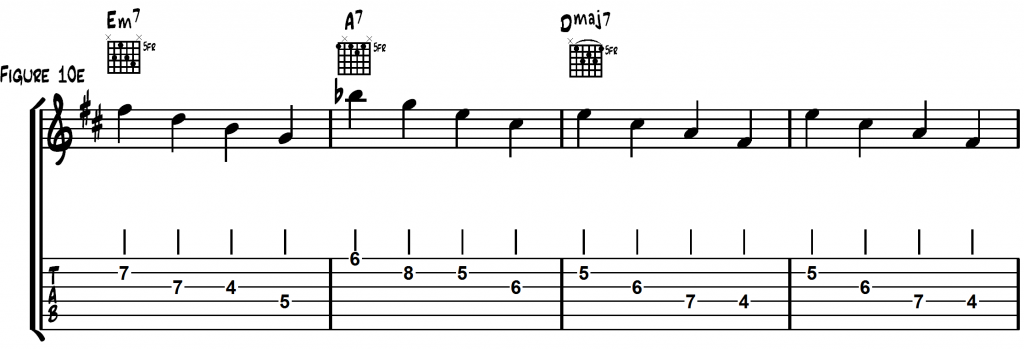Extended Arpeggios on a Jazz II V I Solo
Extended arpeggios are often used by jazz guitar players to add richness and interest to solos. Often jazz players don’t even play the root of the chord that they’re soloing on because the root is normally played by the bass player or sometimes other harmonic instruments too.
Today we are going to be looking at a way to play extended arpeggios which replace the root of the chord with the 9th of the chord.
What is a 9th?
To briefly give some background to this idea (without a lot of theory), let’s look at the scale of D major that we discussed in Chapter 1 – but now we’ll extend it out over 2 octaves:
| D | E | F# | G | A | B | C# | D | E | F# | G | A | B | C# | D |
| 1 | 2 | 3 | 4 | 5 | 6 | 7 | 1/8 | 9 | 3 | 11 | 5 | 13 | 7 | 1 |
Look at the 2nd octave. In this higher octave, if a note is contained within the original chord (D Major 7th) it’s still referred to as a 3rd or 5th or 7th, but the other notes in between are called extensions. These are our 9ths, 11ths and 13ths. They sound rich and interesting when played above the original chords but often search for some kind of resolution to a neighbouring chord tone.
Here’s how to form an extended arpeggio on D Major: Start on the 3rd of the chord, F#. Jump over G and land on A. Jump another note and you play C# and then finally jump a note again and you hit the note E. As you can see above, the note E is the 9th note in the scale of D major and it sounds beautiful and rich against our original D Major 7th chord. We’re still playing 3 notes from the chord of D Major 7th but now instead of the root we’re playing the 9th.
Hear this extended arpeggio against the D Major 7th chord in figure and audio example 10a.

We can repeat this process against the E minor 7 chord.
Starting from the 3rd gives us the notes G B D and F# (F# is the 9th) as in figure and audio example 10b.

Finally let us repeat it with the A7 chord but we are still going to use the b9 from the diminished arpeggio for that authentic bebop flavor. This gives us C# E G and Bb (Bb is the b9) this is shown in figure and audio example 10c.

I have previously stressed to always learn the chord arpeggios beginning from the root. Every time you learn to solo on a new jazz tune you always begin by playing ascending and descending root based arpeggios. Move on to these extended arpeggios only once you have that concept fully grasped. This way you can always visualise and hear ‘home’ on the guitar neck.
Once you’ve learned the shapes you can experiment by playing these extended 3rd–9th arpeggios ascending over the ii V I progression as in figure and audio example 10d. Spend time internalizing this. Once again it’s fundamental to all jazz soloing. Start with the slowest backing track at first. Once you can play this over the backing track, play the exercise just with a metronome and no backing.

When you’re comfortable try playing the arpeggios descending from 9th to 3rd, first with the backing tracks and then with just a metronome. Study figure and audio example 10e.

Extended Arpeggio Guitar Licks
It’s time to add the bebop scale to our ascending 3rd–9th arpeggio. If you’ve done your homework in the previous lessons this shouldn’t be too much trouble. You sound more like Charlie Parker! Check out figure and audio example 10f.

You can start on the 5th, ascend to the 9th and then descend the bebop scale. Look out for the little shimmy to make the bebop note occur on the offbeat over the A7 in figure and audio example 10g.

Figure and audio example 10h re-introduces chromatic passing notes.

Figure and audio example 10i illustrates arpeggio patterns and chromatic approach notes and the bebop scale all in one lick.

I hope you’re getting the idea. Already we’re sounding a lot more harmonically rich and complex. Look at the ideas as concepts from which to investigate writing your own lines.
A useful ways to practice is to solo over a one chord vamp.
When you’re comfortable with these ideas on the E minor 7 move on to the A7 and then the D Major 7th. Finally try applying one melodic structure over the whole progression.
Soon you’ll begin to hear the 9ths as easily as you heard the roots. This is a key stage in learning bebop as the discovery of this concept was a huge milestone in the development of jazz in the 1940’s.
To know that you have fully internalised these ideas you should be able to play them from memory over the backing tracks. Not only that; you should be able to construct your own lines from the concepts discussed and be able to see or hear each note you play as an extension of the underlying chord.
This lesson is taken from my book, Fundamental Changes in Jazz Guitar. It is available from amazon.com.
“The artists you work with, and the quality of your work speaks for itself.”
Tommy Emmanuel
© Copyright Fundamental Changes Ltd 2025
No.6 The Pound, Ampney Crucis, England, GL7 5SA
